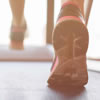
What is Cardiorespiratory Fitness?
Cardiorespiratory fitness is a measure of how well your body is able to transport oxygen to your muscles during prolonged exercise, and also of how well your muscles are able to absorb and use the oxygen, once it has been delivered, to generate adenosine triphosphate (ATP) energy via cellular respiration (cellular respiration is a chemical process in your body's cells that converts the energy stored in the food you eat into the ATP form of energy that is recruited for use by your muscles). Essentially, your cardiorespiratory fitness level is a measure of the strength of your aerobic energy system. If you haven't already read the Exercise Energy Systems article you can do so to get a better understanding of what ATP is, what cellular respiration is, and what the aerobic energy system is (in addition to your body's other two energy systems).
The Basic Physiology of Cardiorespiratory Fitness
According to the definition of cardiorespiratory fitness provided above, it can be broken down into two components. The first component of cardiorespiratory fitness is the ability of your body to transport oxygen to your muscles during prolonged exercise. The second component of cardiorespiratory fitness is the ability of your muscles to absorb and use oxygen while you are exercising. We'll examine each component in more detail.
Let's discuss the first component of cardiorespiratory fitness. Your body's ability to transport oxygen to your muscles is dependent on the coordinated activities of your heart, arteries, veins, and lungs. The process works like this:
- You breathe air into your lungs. The oxygen in the air you breathe is absorbed into the blood in the capillaries that surround your lungs and then transported via the pulmonary vein into the left side of your heart.
- The oxygenated blood is pumped out of the left side of your heart and into the arteries that deliver it throughout your body to your muscles.
- When the oxygenated blood reaches your muscles the oxygen is absorbed into your muscle cells from the blood capillaries that surround them. At the same time that your blood is providing oxygen to your muscles, it is also removing carbon dioxide, a waste product from muscle cellular respiration, from them. The now de-oxygenated and carbon dioxide rich blood is returned to the right side of your heart via your veins.
- The de-oxygenated and carbon dioxide rich blood is pumped out of the right side of your heart to your lungs via your pulmonary artery. Once in the lungs, your blood releases the carbon dioxide into the air that you breathe out and absorbs more oxygen from the air that you breathe in, and the entire process begins again.
Therefore, your cardiorespiratory fitness level is in part (remember, there is a second component to cardiorespiratory fitness yet to be discussed) a measure of how well your heart, arteries, veins, and lungs are able to work together to transport oxygen to your muscles according to the oxygen delivery steps listed above.
Okay, now let's discuss the second component of cardiorespiratory fitness, namely the ability of your muscles to absorb and use oxygen once it has been delivered. This component of cardiorespiratory fitness is dependent on too many factors, both chemical and structural, to address in this article. However, an example of a factor that affects the ability of your muscles to absorb oxygen would be the extent of the blood capillary distribution at your muscles (more blood capillaries means more surface area for oxygen absorption), and an example of a factor that affects the ability of your muscles to use oxygen would be the mitochondrial density of your muscles (mitochondria are organelles in your cells that are primarily responsible for the cellular respiration process that uses oxygen to create ATP energy). Therefore, as demonstrated by the examples given above, your cardiorespiratory fitness level is not only a measure of how well your body transports oxygen to your muscles, but also of how well the oxygen is absorbed and used once it arrives.
How to Measure Cardiorespiratory Fitness
Cardiorespiratory fitness is measured through VO2max testing. VO2max is essentially a measurement of the maximum amount of oxygen that your body is capable of consuming to generate energy that can be used at the cellular level. If you are unfamiliar with the concept of VO2max and how it is measured you can read about it in our VO2 and VO2max article.
The gold standard by which cardiorespiratory fitness is measured requires a VO2max test under laboratory controlled settings with sophisticated equipment. However, if you don't have access to a laboratory equipped for VO2max measurement it is still possible to make a very reasonable estimate of your personal VO2max by trying any one of the four calculators provided on our VO2max calculator page.
How to Improve Cardiorespiratory Fitness
You can improve your cardiorespiratory fitness by performing any type of prolonged exercise that recruits your aerobic energy system. Any exercise activity that gets your heart rate up and keeps it up for a prolonged period of time qualifies as legitimate cardiorespiratory exercise and is beneficial for your aerobic fitness. However, to achieve optimal results from your cardiorespiratory fitness training you should select your activity type, intensity, frequency, and duration according to the guidelines discussed below.
Types of Exercise that Improve Cardiorespiratory Fitness
The American College of Sports Medecine (ACSM) categorizes aerobic (i.e. cardiorespiratory) exercise types into three groups, Group I, Group II, and Group III, based on the skill demands of the activity. They are summarized below.
Group I Cardiorespiratory Exercise Activities
Group I exercise activities require very little skill and provide a constant intensity level. Activities classified as Group I are generally the most ideal for improvement and maintenance of cardiorespiratory fitness. Examples of Group I activities include walking, jogging, running, cycling (on a stationary bicycle), rowing (on a stationary rowing machine), stair climbing (on actual stairs or a machine), and elliptical training (on an elliptical machine).
Group II Cardiorespiratory Exercise Activities
Group II activities require more skill than Group I activities. Intensity level and energy expenditure will be dependent on the skill level of the individual. Group II activities can be as effective as Group I activities for improving and maintaining cardiorespiratory fitness if the person exercising is skilled enough at their chosen activity to maintain the necessary minimum exercise intensity level. Examples of Group II activities include swimming, aerobic dance classes, cycling (on a real bicycle), skating, in-line skating, skipping rope, and nordic skiing.
Group III Cardiorespiratory Exercise Activities
Group III activities incorporate a large variety of skill requirements and intensity levels. They are generally more fun than Group I and Group II activities and are good ways to make cardiorespiratory training more enjoyable. Since the intensity levels are less easily controlled for Group III activities, they are more suitable for the maintenance stage, rather than the improvement stage, of cardiorespiratory fitness training. Examples of Group III activities include racquet sports, basketball, and volleyball.
The Overload Principle
Once you have decided what exercise activity you will perform to improve your cardiorespiratory fitness, you need to decide how long you will do it for, how often, and at what intensity level. Just like building muscle (see the How to Build Muscle article), if you want to improve your cardiorespiratory fitness level you will need to apply the overload principle. This principle simply states that, in order for your cardiorespiratory system (or any other exercise system, for that matter) to improve, you must subject it to demands that are greater than it is accustomed to. If you just go through the motions and your cardiorespiratory system is not subjected to overload you will experience very limited beneficial training adaptations.
So how do you ensure that you are achieving overload during cardiorespiratory training? There are three variables that can be controlled to correctly achieve training overload. They are intensity, duration, and frequency. Intensity is a measure of the extent to which your cardiorespiratory system is being recruited while you exercise. You can gauge the intensity of your exercise from your heart rate. The faster your heart is beating, the greater exercise intensity level is. Duration is a measure of how long your cardiorespiratory exercise lasts for, and frequency is simply a measure of how often you perform cardiorespiratory exercise.
Guidelines for Improving Cardiorespiratory Fitness
The following guidelines are recommended by the ACSM for improvement of cardiorespiratory fitness.
- Question
- At what intensity should I perform my cardiorespiratory training sessions?
- Answer
- Depending on how fit you already are, you should keep your heart rate at a moderate (55% to 69% of your maximum heart rate) or heavy (70% to 89% of your maximum heart rate) intensity level to improve your cardiorespiratory fitness. If you are an absolute beginner, start at 55% of maximum heart rate and gradually increase your intensity level as your fitness level improves. Essentially, you want your intensity level to be such that you always feel somewhat challenged, but not prohibitively so. Visit our Target Heart Rate Calculator to determine your ideal heart rate training zones.
- Question
- How long should each cardiorespiratory training session last?
- Answer
- Anywhere from 20 minutes to 60 minutes. The longer you train for, the greater your training adaptive response will be, as long as you don't overdo it.
- Question
- How often should I train my cardiorespiratory fitness?
- Answer
- Three to five days per week. The more often you train, the greater your training adaptive response will be, as long as you don't overdo it. Your body needs rest periods to adapt to and recover from the stress it is put under while you train.
Cardiorespiratory Training Advice for Beginners
Okay, there you have it. Now you know what cardiorespiratory fitness is and how to improve it. Keep in mind that if you are just beginning to train your cardiorespiratory fitness you should start at the easier end of the intensity, duration, and frequency ranges given above and slowly increase them as you progress. For example, an absolute beginner might want to try starting out at an intensity of 55% of their maximum heart rate, for 20 minutes, three times a week. But if that is too hard don't despair! It's okay to reduce your intensity for a "breather" if that's what you need to do to keep yourself moving for the full 20 minutes. For example, if you are jogging but can't do it for a complete 20 minutes at first it is absolutely fine to slow down and take walking breaks whenever you need them. Think of it this way, if you can't finish the 20 minutes without stopping then your body is obviously being stressed beyond what it is accustomed to, and therefore you have subjected it to the desired overload. This will be enough to stimulate an adaptive response (your body will realize that it needs to strengthen its cardiorespiratory system and adjust accordingly), and things will be slightly easier next time. Just finish the 20 minutes with as many breaks as you need and eventually you'll find that the number of breaks you need decreases until you don't need any. Then you can gradually increase your intensity, duration, and frequency by changing them in the ways that you are comfortable with. Finally, try to make your cardiorespiratory exercise something that you enjoy so that you will continue to do it.






